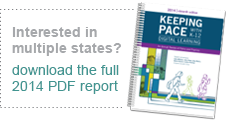Data & Information
Kansas
Fully online schools
Kansas has a number of full-time online schools. In SY 2012-13 the state counted 4,689 fully online K-12 students and an additional 1,220 taking supplemental and/or blended options. Online elementary and middle schools in small, rural communities often serve fewer than 100 students, with some exceptions, e.g.—the Lawrence Virtual School, the largest virtual school in the state.
State virtual school
Kansas does not have a state virtual school.
District programs
In SY 2013-14, KSDE reported 5,136 full-time students and 5,559 part-time students, and a total of 6,552 FTEs. Part-time students were enrolled in either blended learning programs, advanced or credit recovery courses, or supplemental courses for homeschooled students. About 30% of virtual education students study at the elementary school level, with 25% at the middle school level and 45% at the high school level. The number of full-time students increased by 699 (15%) since SY 2011-12, while the number of part-time students decreased by 400 (25%); many shifted from part- to full-time status.
Kansas Online Learning Program (KOLP) started in 2010 and offers online courses to grades K-12 through the Centre School District. In 2011, KOLP created the adult learning initiative to help adults obtain a high school diploma.
Online learning policy history
A state audit released in April 2007 questioned whether the Department’s policies were being carried out appropriately. A law passed in 2008, SB669 (the Virtual School Act), increased supervision and regulation of all virtual schools by the department, and changed funding of online students. All virtual schools/programs must be registered in order to claim FTE funding and are audited on an annual basis. Additional policy for online program is defined in a legislative brief and documents available on the KSDE website, including an extensive explanation of Virtual Education Requirements. The policies define:
- virtual schools,
- registration and reporting requirements for online programs,
- funding and attendance information, and
- quality assurance and accountability information for online programs, including communication guidelines.
The Virtual School Act altered the funding of online students such that all full-time virtual students are funded at 1.05 (105%) of base FTE. The base state aid per pupil in SY 2012-13 was $3,838; full-time virtual students received $4,030. A number of other factors may impact funding:
- Virtual students are eligible for two additional weightings: non-proficient at-risk and Advanced Placement, which can increase the amount funded by up to 25%. Schools with a higher proportion of at-risk-weighted students receive a larger amount per pupil.
- As students may attend both a traditional school and a virtual school, funding levels may be affected by whether these schools are in the same or different districts.
- Students who attend a district’s virtual school as well as a local traditional school will be counted by the school at which they undertake the most coursework. If countable time is more than 50% virtual, the student will be counted as virtual for funding purposes.
Blended learning
In SY 2012-13 the state counted 4,689 fully online K-12 students and an additional 1,220 taking supplemental and/or blended options.
last updated October 15, 2014
back to map


